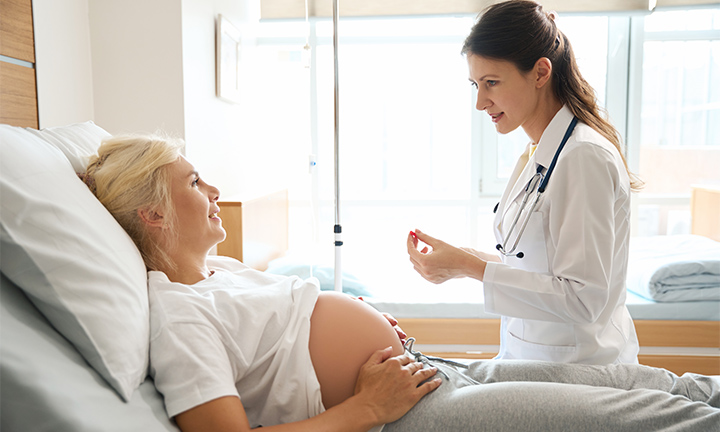
Signs of Labor: Early Indications Labor Is Near
How does labor start? Water breaking? Contractions? Those are both sure signs of labor, but sometimes, the signs labor is near are more subtle. A woman’s body almost always gives her the signals she needs and the inner wisdom to recognize them; however, to help you understand them, we’ve compiled a list of the most common signs of labor.
Learn about the different stages of labor, the differences between true and false labor, the signs and symptoms of both early and active labor, and what to do when you think your baby is coming!
What Is Labor?
Labor, more commonly called childbirth, is the experience of delivering your baby from the warm and cozy home of your uterus to the outside world. You’ve probably been excitedly and anxiously awaiting this moment for quite some time, but it’s important to understand that labor is a slow, multistep process that’s unique for each woman and each pregnancy. That said, labor tends to follow a general pattern for most women. Knowing about what’s likely to happen can help you prepare for the big day ahead.
When Does Labor Start?
Although your due date is usually calculated according to the average length of pregnancy, which is 40 weeks for a full-term pregnancy, don’t expect your baby to arrive on the dot. A pregnancy can last between 41 and 42 weeks, which is referred to as late term, and even last longer than 42 weeks, which is called postterm.
It's also not uncommon for labor to begin earlier than 40 weeks, such as at week 38 or 39. Going into labor before 37 weeks of pregnancy is called preterm labor. This sometimes stops on its own without leading to preterm birth but will always need immediate medical attention.
If your due date has come and gone, you may be eager for labor to begin. You might have heard of traditional methods of inducing labor, such as drinking castor oil, which has not shown to be effective. In fact, experts don’t recommend trying any kind of home remedy. So, if you’re concerned labor hasn’t started yet, the best thing to do is consult your healthcare provider.
Stages of Labor
Childbirth is broken down into three stages:
Signs and Symptoms of Labor
Labor is a different experience for every woman and can vary from pregnancy to pregnancy for the same woman. But there are some similarities. Here are the 10 most common signs of labor in most women:
Learn more about these signs and symptoms of labor in the following two sections, which cover the two phases (early and active labor) of stage 1 of labor.
Signs and Symptoms of Early Labor
Early labor can be unpredictable in terms of duration. It may be hours or even days before you progress to active labor, especially if this is your first baby. This time will usually become shorter with subsequent deliveries. Until your contractions become more regular and more intense, or your water breaks, try to stay relaxed—active labor will eventually start.
Although every pregnancy is different, you may experience the following signs of early labor, some more subtle than others:
Signs and Symptoms of Active Labor
Active labor is when things start to really happen, and it’s when you should head to the hospital. Active labor can last from four to eight hours, and sometimes even longer. By this time your cervix may likely be dilated from 6 to 10 centimeters, and you will notice stronger signs and symptoms that you’re in labor:
True Labor Vs. False Labor
Sometimes you may feel as if you’re going into labor, but it’s not real labor. So, how can you tell the difference between the signs of true and false labor (known as Braxton Hicks contractions)? A tried-and-true method of telling the difference is by timing the contractions and making note of whether the contractions go away when you move.
Use the table below to help distinguish between true and false labor:
What to Do During Early Labor
In early labor, with only a few signs of labor, you may not need to go to the hospital just yet. Labor can take a lot of time, and you’ll may be more comfortable, and perfectly safe, staying
at home. If at any point you’re concerned about what you’re experiencing, reach out to your healthcare provider.
Realizing you’re in labor can bring feelings ranging from excitement to disbelief or apprehension. Try to stay calm and focused. Arrange to have your partner or friend with you to help record labor symptoms, keep you company, and get you to the hospital when the time comes.
You can also try to ease any discomfort by
You can learn more about when to go to hospital for labor from a nurse in the video below.
When to Call Your Healthcare Provider and Go to the Hospital
If you have any doubt about whether you’re in labor, call your healthcare provider for advice.
Be sure to call your healthcare provider or go to the hospital if you’re experiencing any of these signs:
FAQS AT A GLANCE
Signs of early labor may indicate that labor is near or has begun. These signs can include:
- Nesting, which is a sudden burst of energy to get everything ready before your baby arrives.
- Lightening, when your baby drops lower into your pelvis, relieving some pressure from your diaphragm.
- Mild contractions that you may feel in your back and abdomen that happen 5 to 15 minutes apart and last for between 60 and 90 seconds.
- Effacement, when your cervix thins, softens, and shortens.
- Dilation, when your cervix begins to open.
- Loss of your mucus plug, which you’ll notice as a thick, pinkish or blood-streaked vaginal discharge.
The Bottom Line
As your due date approaches, keep an eye out for the signs of labor and have your birth plan ready. If you haven’t made a birth plan yet, you can find out how to make one and what to include in your birth plan.
It’s very unlikely that you will suddenly go into labor without warning. Your body will probably let you know that you’re close to the big day. Make sure your hospital bag is packed so that you’re ready to leave when the time is right.
Knowing you’re prepared will help reduce anxiety when you notice those first signs of labor. You’re nearing the end of your pregnancy, and you’re about to bring your baby into the world. You can do this!
In the meantime, stock up on diapers to get rewarded in Pampers Cash every time you add a code in the Pampers Rewards app.
- ACOG
- March of Dimes: Stages of labor
- ACOG: When pregnancy goes past your due date
- Mayo Clinic: Preterm labor
- ACOG: Preterm labor and birth
- Mayo Clinic: Inducing labor
- Kids Health: Inductions
- Mayo Clinic: Signs of labor
- ACOG: How to tell when labor begins
- March of Dimes: Amniotic fluid
- Mayo Clinic: Bleeding during pregnancy
- Mayo Clinic: Preeclampsia
Read more about Pregnancy
Related Articles
Join a World of Support
through Pregnancy and Parenthood.
TRACK WITH TOOLS
LEARN WITH EXPERTS
GET REWARDED















